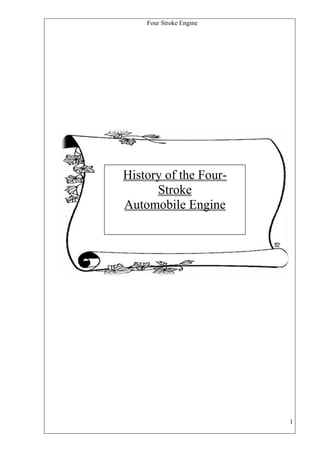The document provides an overview of four-stroke engines, including:
- The four strokes that make up the combustion cycle: intake, compression, power/ignition, and exhaust.
- Key components of four-stroke engines like the intake/exhaust valves, piston, crankshaft, and spark plug.
- The basic operation of a four-stroke petrol/gasoline engine, which draws in an air-fuel mixture, compresses it, ignites it with a spark plug, and exhausts the gases.

![Four Stroke Engine
History of the Four-Stroke
Automobile Engine
Perhaps the most well known engine type in the world, the automotive fourstroke engine has become the power plant of choice for today's consumers
due to itsgreater efficiency and cost effectiveness over alternate
reciprocating engines.The story of the internal combustion engine began in
1680 with a Dutch physi-cist, Christian Huygens, who conceptually
designed an engine fueled by gun powder. However, the first internal
combustion engine was actually built by a Sweetish
inventor by the name of Francios Isaac de Rivaz in 1807. Through the
combustionof a hydrogen and oxygen mixture, his engine, with some
difficulty, powered acrudely constructed automobile. As the years went on,
other inventors modified the design to be fueled by anything from gasoline
to coal. The next greatest leap came in 1862 when a French engineer,
Alphonse Beau de Rochas, designed and patented the first four-stroke
engine. In 1864 an Austrian engineer, Siegfried Marcus, build the first gasoline powered vehicle, which was comprised of a cart
and a one cylinder engine. But the biggest break through came in 1876
when Nikolaus August Otto invented the first successful four-stroke engine,
aptly nick-namingthe four-stroke cycle the ”Otto Cycle.” [1] The next great
milestone in the development of the four stroke engine was achieved by
Gottlieb Daimler in 1885, who invented an engine with a vertical positioned
cylinder, fueled by gasoline injected into a cylinder chamber through a
carburetor. The innovations from these important inventors over the years
culminated in Daimler's engine which is commonly referred to as the ”blue
print” to the modern day internal combustion engine. [1] From the inception
of the four-stroke internal combustion engine, many paths have been
explored and followed to create the superior design, especially in the
configuration of the cylinders. In general, there are seven types of
reciprocating engine designs, an engine that employs one or more cylinders
in which a piston(s) reciprocates back and forth. The first of these designs
was the single cylinder engine. After its success, designers began to play
with twin engines, or two cylinder engines which lead to the In-Line
Engine, the V Engine, the Opposed Cylinder Engine, the W engine, the
Opposed Piston Engine, and the Radial Engine. These different setups
where further explored with engines such as the Vauxhall Wyvern and
Velox engines to the Ford V-Four engine, utilizing an even greater numbers
of cylinders than the original twin engines.
2](https://image.slidesharecdn.com/fourstrokeengine-140224080304-phpapp02/85/four-stroke-engine-2-320.jpg)


























